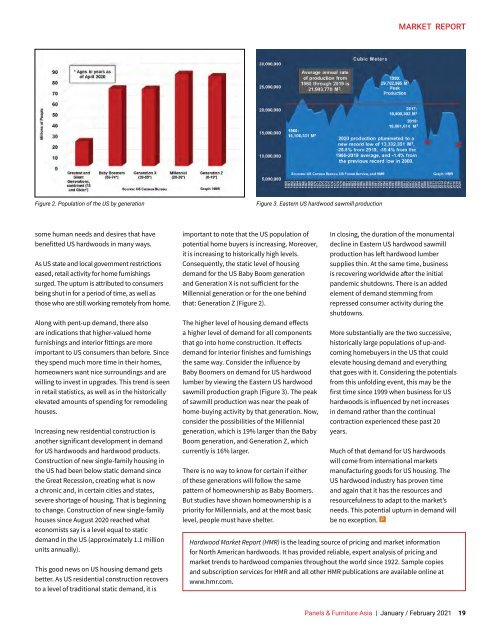Panels & Furniture Asia January/February 2021
Panels & Furniture Asia (PFA) is a leading regional trade magazine dedicated to the woodbased panel, furniture and flooring processing industry. Published bi-monthly since 2000, PFA delivers authentic journalism to cover the latest news, technology, machinery, projects, products and trade events throughout the sector. With a hardcopy and digital readership comprising manufacturers, designers and specifiers, among others, PFA is the platform of choice for connecting brands across the global woodworking landscape.
Panels & Furniture Asia (PFA) is a leading regional trade magazine dedicated to the woodbased panel, furniture and flooring processing industry. Published bi-monthly since 2000, PFA delivers authentic journalism to cover the latest news, technology, machinery, projects, products and trade events throughout the sector. With a hardcopy and digital readership comprising manufacturers, designers and specifiers, among others, PFA is the platform of choice for connecting brands across the global woodworking landscape.
Create successful ePaper yourself
Turn your PDF publications into a flip-book with our unique Google optimized e-Paper software.
MARKET REPORT<br />
Figure 2. Population of the US by generation<br />
Figure 3. Eastern US hardwood sawmill production<br />
some human needs and desires that have<br />
benefitted US hardwoods in many ways.<br />
As US state and local government restrictions<br />
eased, retail activity for home furnishings<br />
surged. The upturn is attributed to consumers<br />
being shut in for a period of time, as well as<br />
those who are still working remotely from home.<br />
Along with pent-up demand, there also<br />
are indications that higher-valued home<br />
furnishings and interior fittings are more<br />
important to US consumers than before. Since<br />
they spend much more time in their homes,<br />
homeowners want nice surroundings and are<br />
willing to invest in upgrades. This trend is seen<br />
in retail statistics, as well as in the historically<br />
elevated amounts of spending for remodeling<br />
houses.<br />
Increasing new residential construction is<br />
another significant development in demand<br />
for US hardwoods and hardwood products.<br />
Construction of new single-family housing in<br />
the US had been below static demand since<br />
the Great Recession, creating what is now<br />
a chronic and, in certain cities and states,<br />
severe shortage of housing. That is beginning<br />
to change. Construction of new single-family<br />
houses since August 2020 reached what<br />
economists say is a level equal to static<br />
demand in the US (approximately 1.1 million<br />
units annually).<br />
This good news on US housing demand gets<br />
better. As US residential construction recovers<br />
to a level of traditional static demand, it is<br />
important to note that the US population of<br />
potential home buyers is increasing. Moreover,<br />
it is increasing to historically high levels.<br />
Consequently, the static level of housing<br />
demand for the US Baby Boom generation<br />
and Generation X is not sufficient for the<br />
Millennial generation or for the one behind<br />
that: Generation Z (Figure 2).<br />
The higher level of housing demand effects<br />
a higher level of demand for all components<br />
that go into home construction. It effects<br />
demand for interior finishes and furnishings<br />
the same way. Consider the influence by<br />
Baby Boomers on demand for US hardwood<br />
lumber by viewing the Eastern US hardwood<br />
sawmill production graph (Figure 3). The peak<br />
of sawmill production was near the peak of<br />
home-buying activity by that generation. Now,<br />
consider the possibilities of the Millennial<br />
generation, which is 19% larger than the Baby<br />
Boom generation, and Generation Z, which<br />
currently is 16% larger.<br />
There is no way to know for certain if either<br />
of these generations will follow the same<br />
pattern of homeownership as Baby Boomers.<br />
But studies have shown homeownership is a<br />
priority for Millennials, and at the most basic<br />
level, people must have shelter.<br />
In closing, the duration of the monumental<br />
decline in Eastern US hardwood sawmill<br />
production has left hardwood lumber<br />
supplies thin. At the same time, business<br />
is recovering worldwide after the initial<br />
pandemic shutdowns. There is an added<br />
element of demand stemming from<br />
repressed consumer activity during the<br />
shutdowns.<br />
More substantially are the two successive,<br />
historically large populations of up-andcoming<br />
homebuyers in the US that could<br />
elevate housing demand and everything<br />
that goes with it. Considering the potentials<br />
from this unfolding event, this may be the<br />
first time since 1999 when business for US<br />
hardwoods is influenced by net increases<br />
in demand rather than the continual<br />
contraction experienced these past 20<br />
years.<br />
Much of that demand for US hardwoods<br />
will come from international markets<br />
manufacturing goods for US housing. The<br />
US hardwood industry has proven time<br />
and again that it has the resources and<br />
resourcefulness to adapt to the market’s<br />
needs. This potential upturn in demand will<br />
be no exception. P<br />
Hardwood Market Report (HMR) is the leading source of pricing and market information<br />
for North American hardwoods. It has provided reliable, expert analysis of pricing and<br />
market trends to hardwood companies throughout the world since 1922. Sample copies<br />
and subscription services for HMR and all other HMR publications are available online at<br />
www.hmr.com.<br />
<strong>Panels</strong> & <strong>Furniture</strong> <strong>Asia</strong> | <strong>January</strong> / <strong>February</strong> <strong>2021</strong> 19


















